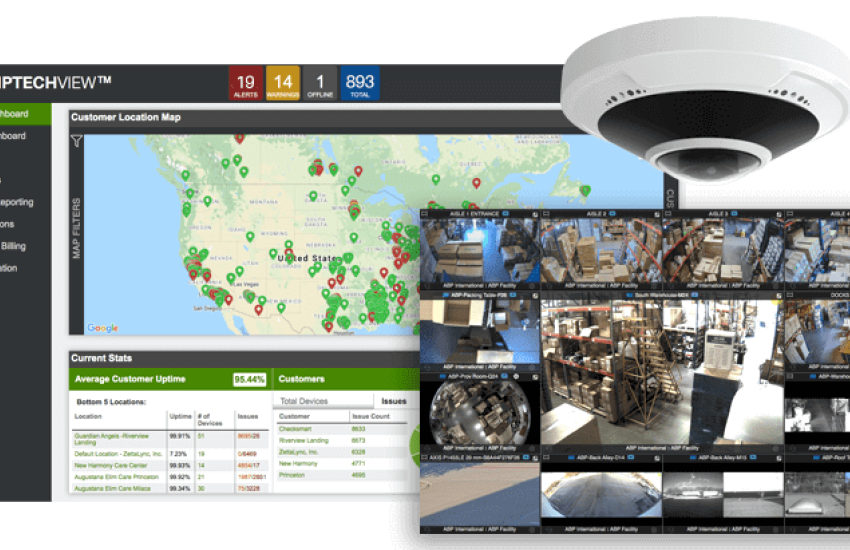VSaaS Market Size: A Comprehensive Study
Video Surveillance as a Service, often shortened to VSaaS, has truly changed the game in how we approach security and surveillance. It allows for monitoring places without being there.
This technology started in 2002 and has protected many properties. The VSaaS market is growing rapidly. We will look into statistics, future predictions, and important trends. We'll also examine what is pushing this market forward.
What is VSaaS?

VSaaS stands for a service that taps into the power of cloud computing to handle video surveillance. It lets people look at and handle video footage online. Instead of keeping video data on local servers or recording devices, it stores the data on remote cloud servers. This way, users can watch recorded videos from anywhere as you just need a device with internet access.
Global VSaaS market size in recent years
The demand for VSaaS is skyrocketing. People increasingly want the ability to monitor places in real-time. This sector has seen steady growth for a while now. By 2020, its worth will hit about 2.2 billion dollars. Since that time, it's been climbing at a notable pace each year. Predictions are that by 2025 or 2026, we could be looking at a market worth over 4 billion dollars.
This surge reflects a worldwide quickening in embracing VSaaS solutions. Furthermore, The worldwide Video Surveillance as a Service market is expected to reach 7.6 billion dollars by 2027. It's growing fast, with an annual growth rate of 18% predicted over the next few years.
Key trends and drivers
Cloud-based solutions are popular for their scalability, flexibility, and cost savings factors. They are replacing old surveillance methods. Artificial intelligence (AI) and machine learning are improving VSaaS. There's more demand for watching places remotely, especially after COVID-19. People want to keep places safe without being there.
Smart city projects also boost the VSaaS market. Governments are investing in smart safety and surveillance to improve city life. VSaaS is important for these projects because it can handle large amounts of data and offers detailed analytics. New data protection laws, like GDPR in Europe, make secure data handling crucial. VSaaS providers must ensure their systems protect privacy. VSaaS is also merging with the Internet of Things (IoT). This combination creates advanced security systems.
Market Segmentation

The VSaaS market can be categorized in various ways:
- By Service Type: Services range from simple monitoring to complex data analysis.
- By Vertical: Industries such as retail, finance, and government utilize VSaaS.
- By Region: The popularity and use of VSaaS differ around the globe. Some areas adopt it more quickly.
VSaaS Components
The VSaaS model uses cloud storage for video footage. This method is scalable, flexible, and cost-effective. Users can change their storage space as needed without buying more hardware. VSaaS includes remote viewing, allowing video access from anywhere. This is useful for those needing to watch their properties remotely.
Advanced video analytics identify events, behaviors, or patterns in real-time. This improves security and efficiency. Additionally, VSaaS protects data with encryption and secure protocols. It can also connect with other security systems and IoT devices, making it a more complete security solution.
Regional Analysis of the VSaaS Market
The VSaaS market is growing fast across different parts of the world. Each region has its reasons for this growth. North America is a big market for VSaaS because of its advanced tech, focus on security, and big companies offering these services. Demand here comes from retail, banking, and government sectors. Europe's market is also big, growing because of security worries, smart city projects, and strict data laws like GDPR. The UK, Germany, and France are leading in adopting VSaaS.
Asia-Pacific is seeing fast growth in VSaaS because of city development, smart city projects, and more investment in public facilities. China, India, Japan, and South Korea are driving this growth. The Middle East and Africa are growing due to a need for better security and smart city tech adoption. The Gulf countries, in particular, are quickly adopting VSaaS.
Latin America is also growing as more people see the benefits of cloud-based security. Brazil, Mexico, and Argentina are ahead in this. The demand for VSaaS across these regions shows a global move towards cloud-based, smart surveillance solutions. These solutions are scalable, offer advanced analysis, and can be monitored remotely.
Who Are The Key Players in the VSaaS Market?

These are some key players currently in the market:
- Axis Communications: offers a wide range of products like IP cameras and video software.
- Bosch Security Systems: provides various security solutions, including cloud services. Honeywell: offers VSaaS that works with other security systems.
- Cisco: provides cloud-based surveillance and analytics.
- Genetec: known for its unified security solutions that are scalable and flexible.
- Johnson Controls: offers cloud surveillance under the Tyco brand. Verkada specializes in cloud.
Challenges and Constraints
Data breaches and following data protection laws like GDPR are major hurdles. VSaaS companies need strong security and data handling practices. Compatibility with old systems is another challenge. Many places already have surveillance setups. VSaaS needs to work with these systems smoothly. Cost is important too. While VSaaS has benefits, companies must think about all related costs.
FAQs
What drives VSaaS market growth?
The demand for enhanced security, the benefits of cloud-based services, and technological progress made in recent years contribute as driving factors.
How is the VSaaS market segmented?
It's segmented by service type, vertical, and region.
Which regions lead in the VSaaS market?
North America holds the largest portion of the market. Europe comes next, with the Asia-Pacific region following.
What challenges do industry players face?
Challenges include privacy concerns, the need for reliable internet, and the costs of cloud storage.
What are the major trends and future opportunities?
Artificial intelligence and machine learning provide a chance to improve the effectiveness of surveillance.
Conclusion
The market for VSaaS is growing undeniably. It provides a flexible and secure approach to surveillance. Even with some obstacles, the outlook is positive. Advances in technology will keep fueling progress and new developments in this area.
References:
- https://medium.com/@cognitive_/video-surveillance-as-a-service-vsaas-market-size-was-usd-3-5-9b6b844434ed
- https://www.einpresswire.com/article/668175841/video-surveillance-and-vsaas-market-2030-rising-demand-and-international-forecast-scope-led-by-top-key-players
- https://www.linkedin.com/pulse/2031-vsaas-market-regional-analysis-insights-rbqkf
- https://www.marketsandmarkets.com/Market-Reports/video-surveillance-as-a-service-market-773.html


